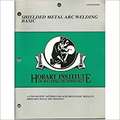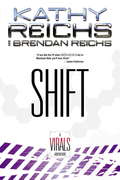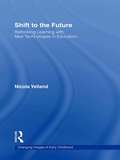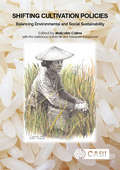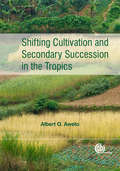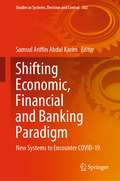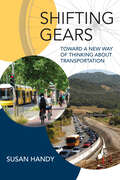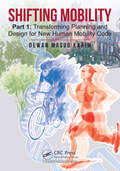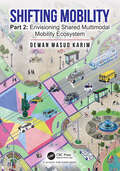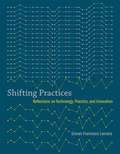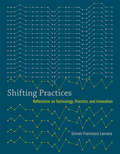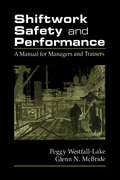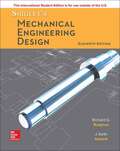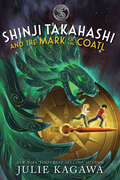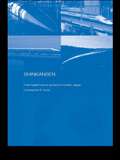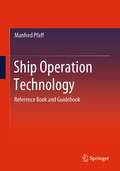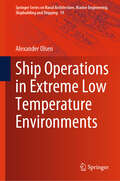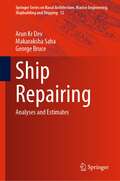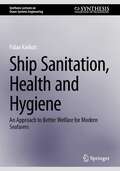- Table View
- List View
Shielded Metal Arc Welding Basic
by Hobart Institute of Welding TechnologyA STEP-BY-STEP METHOD FOR ACQUIRING BASIC SKILLS IN SHIELDED METAL ARC WELDING
Shielding of Electromagnetic Waves: Theory and Practice
by George M. KunkelThis book provides a new, more accurate and efficient way for design engineers to understand electromagnetic theory and practice as it relates to the shielding of electrical and electronic equipment. The author starts by defining an electromagnetic wave, and goes on to explain the shielding of electromagnetic waves using the basic laws of physics. This is a new approach for the understanding of EMI shielding of barriers, apertures and seams. It provides a reliable, systematic approach that is easily understood by design engineers for the purpose of packaging the electrical and electronic systems of the future. This book covers both theory and practical application, emphasizing the use of transfer impedance to explain fully the penetration of an electromagnetic wave through an EMI gasketed seam. Accurate methods of testing shielding components such as EMI gaskets, shielded cables and connectors, shielded air vent materials, conductive glass and conductive paint are also covered.Describes in detail why the currently accepted theory of shielding needs improvement.Discusses the penetration of an electromagnetic wave through shielding barrier materials and electromagnetic interference (EMI) gasketed seams.Emphasizes the use of transfer impedance to explain the penetration of an electromagnetic wave through an EMI gasketed seam.The definition of an electromagnetic wave and how it is generated is included.Chapter in the book are included that reinforce the presented theory.
Shift
by Kathy Reichs Brendan ReichsTory's great aunt, Temperance Brennan, visits just in time to investigate a robbery at the Loggerhead Island Research Institute. <P><P>As a renowned forensic anthropologist, Tempe is obviously qualified to figure out whodunit, but Tory and her Virals pack want to crack the case on their own. Yet the crime is puzzling. Who could have accessed the labs at LIRI, and how could they have gotten the equipment off the island? <P> It's Brennan vs. Brennan in this short story that gives readers a brand new insight into the world of the Virals.
Shift to the Future: Rethinking Learning with New Technologies in Education (Changing Images of Early Childhood)
by Nicola YellandNew technologies are dramatically changing the face of education and the nature of childhood itself. In Shift to the Future, Nicola Yelland examines the ways in which these technologies are reshaping the social, personal, and educational experiences of childhood, and explores the curricular revisions such changes demand. With a focus on the various information and communications technologies (ICTs) available to young students and the possibilities these ICTs offer for teaching and learning, Shift to the Future provides inspiring examples of teachers who have innovatively incorporated new technologies into their classrooms to engage their students in contemporary times.
Shifting Cultivation Policies: Balancing Environmental and Social Sustainability
by Malcolm CairnsShifting cultivation supports around 200 million people in the Asia-Pacific region alone. It is often regarded as a primitive and inefficient form of agriculture that destroys forests, causes soil erosion and robs lowland areas of water. These misconceptions and their policy implications need to be challenged. Swidden farming could support carbon sequestration and conservation of land, biodiversity and cultural heritage. This comprehensive analysis of past and present policy highlights successes and failures and emphasizes the importance of getting it right for the future. This book is enhanced with supplementary resources. The addendum chapters can be found at: www. cabi. org/openresources/91797
Shifting Cultivation Systems: From Indigenous Practices to Soil Fertility in North-East India
by Shri Kant Tripathi Francis Q. BrearleyThis book discusses indigenous practices and obstacles faced by farmers conducting shifting cultivation (jhum) in North-east India and suggests methods of soil fertility improvement through e.g. microbial-mediated rejuvenation of forest fallows as a sustainable approach for mitigating deteriorating jhum lands and enhancing their productivity. Shifting cultivation has experienced a decline in crop productivity due to high population density and shortened fallow length that has impacted upon farmers' socio-economic status, and raised concerns regarding food security and environmental conservation. As shifting cultivation is conducted in moist tropical forests globally supporting millions of people, there is the potential to benefit many populations. This book is suitable for researchers, policy makers, development agencies, NGOs and farmers to formulate strategies that conserve the biodiversity, environment, soil health and traditions of tribal farming communities.
Shifting Cultivation and Secondary Succession in the Tropics
by Albert AwetoShifting cultivation or rotational bush fallowing is the predominant system of arable farming in the humid and sub-humid tropics where several hundred million people depend on this system of agriculture for their livelihood. Shifting Cultivation and Secondary Succession in the Tropics documents and systematizes findings in shifting cultivation over the last six decades and also characterizes secondary succession and related changes that fallow vegetation undergoes to the process of soil fertility restoration under bush fallow. It includes unique features such as graphical illustration of the organic matter equilibrium concept; correlation and multiple regression analysis; core-periphery analogy, encapsulated in the spatio-temporal model and the graphical unified model of succession and soil fertility restoration, therefore providing essential reading for researchers and students within tropical agriculture and related fields such as forestry, geography, environmental science and tropical development.
Shifting Economic, Financial and Banking Paradigm: New Systems to Encounter COVID-19 (Studies in Systems, Decision and Control #382)
by Samsul Ariffin Abdul KarimThis book presents the main ideas on shifting the economy, finance, and banking sectors among ASEAN countries into a new paradigm. Since the economy and finance, as well as the banking sector in the ASEAN region, have been growing years by years, there is the need for the policymakers and relevant agencies to study the ideas on shifting the ASEAN economy, finance, and banking towards globalization through a new paradigm. Furthermore, the recent COVID-19 pandemic has affected not just human lives but also the economic and financial sectors. Because of COVID-19, most countries around the world have imposed lockdown and moving control order (MCO) as well as conditionally moving control order (CMCO). In this book, we tackle the main ideas on shifting the economy, finance, and banking sectors among ASEAN countries into a new paradigm. The researchers used econometric, mathematics, statistics, and quantitative sciences to study many economic, finance, and banking issues such as cryptocurrency, consumer preferences, and good governance. This book presents various new and novel results, methods, and algorithms. The findings of this book shall benefit the ASEAN policymakers, investors, and other relevant agencies. This book is also suitable for postgraduate students, researchers, and other scientists who work in econometric, finance, banking, and numerical simulation.
Shifting Gears: Toward a New Way of Thinking about Transportation (Urban and Industrial Environments)
by Susan HandyAn expertly woven history and critique of the ideas shaping transportation in the United States.Excruciating traffic jams. Struggling transit agencies. An epidemic of pedestrian fatalities. It is clear that transportation is not working in the United States and that we need to rethink our approach. In Shifting Gears, Susan Handy provides an in-depth history of the ideas embedded in American transportation policy and the emergence of new ways of thinking that could give us better transportation options. Weaving in bits of her own personal narrative, Handy gives readers a deeper and clearer understanding of our transportation system and the roots of its successes and failures.Handy covers the myriad costs of car ownership, the futility of expanding highways, and the misplaced faith in technological innovation. She offers new ideas and strategies that can improve the health of our car-centric transportation system—most crucially, the idea that communities across the country must create an array of choices for daily travel. Shifting Gears asserts that a diverse transportation ecosystem is essential for creating more just, sustainable communities, but getting there will take a dramatic shift in how we think about transportation.
Shifting Ground: The Changing Agricultural Soils of China and Indonesia
by Peter H. LindertIn this book Peter Lindert evaluates environmental concerns about soil degradation in two very large countries--China and Indonesia--where anecdotal evidence has suggested serious problems. Lindert does what no scholar before him has done: using new archival data sets, he measures changes in soil productivity over long enough periods of time to reveal the influence of human activity. China and Indonesia are good test cases because of their geography and history. China has been at the center of global concerns about desertification and water erosion, which it may have accelerated with intense agriculture. Most of Indonesia¹s lands were created by volcanoes and erosion, and its rapid deforestation and shifting slash-burn agriculture have been singled out for international censure. Lindert's investigation suggests that human mismanagement is not on average worsening the soil quality in China and Indonesia. Human cultivation lowers soil nitrogen and organic matter, but has offsetting positive effects. Economic development and rising incomes may even lead to better soil. Beyond the importance of Lindert's immediate findings, this book opens a new area of study--quantitative soil history--and raises the standard for debating soil trends.
Shifting Mobility: Part 1: Transforming Planning and Design for New Human Mobility Code
by Dewan Masud KarimIn the face of resource depletion, environmental changes, lifestyle changes, demographic and digital adaptation, old ideologies of city building and expensive and complex automobility solutions are in freefall. These changes are creating severe friction between the old and new paradigms. This book provides new perspectives through the process of ideological disassociation and concepts of human mobility code. The basic premise of the book, human mobility is an essential component of our creativity that comes from our unconscious desire to become a part of a community. Several new concepts in the book starts with the hallmark of new discovery of human mobility code and its implications of urban mobility boundary systems to stay within safe planetary zone. A new discovery of human mobility code from comprehensive research finding prove that each individual develops a unique mobility footprint and become our mobility identity. Beyond individual hallmarks, human develops collective mobility codes through interaction with the third space on which entire mobility systems lie and are created by the fundamentals of city planning and the design process. Readers are introduced to an innovative mobility planning process and reinvention of multimodal mobility approaches based on new mobility code while formulating new concepts, practical solutions and implementation techniques, tools, policies, and processes to reinforce low-carbon mobility options while addressing social equity, environmental, and health benefits. Finally, the book arms us with knowledge to prevent the disaster of full technological enlightenment against our natural human mobility code.
Shifting Mobility: Part 2: Envisioning Shared Multimodal Mobility Ecosystem
by Dewan Masud KarimEmbark on a journey into the heart of a new industrial revolution—one that promises to redefine human mobility for generations to come. In this groundbreaking exploration, we confront the promises and perils of new mobility, navigating the intricate landscape where technology intersects with urban society. As cities evolve and technology shapes our daily lives, the ethical dimensions of this transformation remain largely uncharted territory. Amidst the rapid advancement of new mobility systems, this book sheds light on the moral dilemmas and philosophical underpinnings that often go unnoticed. From the ethical implications of technology to the systemic flaws in planning and design, we delve into the core of this paradigm shift. By understanding the foundational principles of mobility and the hidden codes that govern human movement, we pave the way for a more equitable and inclusive future. At the heart of this transformative vision lies a comprehensive framework for building a new mobility ecosystem—one that prioritizes human well-being and equity above all else. Through innovative planning processes and redesign concepts, we aim to bridge the gap between technology and society, ensuring that every individual has access to safe, efficient, and sustainable modes of transportation. From low-emission vehicles to multimodal transit hubs, this book presents a blueprint for reimagining urban spaces and redefining the way we move. By embracing shared values and collective responsibility, we strive to create a world where mobility is not just a privilege, but a fundamental human right. As we embark on this journey towards a more sustainable future, let us remember that the true measure of progress lies not in technological innovation alone, but in our ability to build communities that thrive together. Join us in shaping the future of mobility—one where humanity and equity reign supreme.
Shifting Practices: Reflections on Technology, Practice, and Innovation
by Giovan Francesco LanzaraWhat happens in an established practice or work setting when a novel artifact or tool for doing work changes the familiar work routines? Any unexpected event, or change, or technological innovation creates a discontinuity; organizations and individuals must reframe taken-for-granted assumptions and practices and reposition themselves. To study innovation as a phenomenon, then, we must search for situations of discontinuity and rupture and explore them in depth. In Shifting Practices, Giovan Francesco Lanzara does just that, and discovers that disruptions and discontinuities caused by the introduction of new technologies often reveal aspects of practice not previously observed.After discussing methodological and research issues, Lanzara presents two in-depth studies focusing on processes of design and innovation in two different practice settings: music education and criminal justice. In the first, he works with the music department of a major American university to develop Music LOGO, a computer system that allows students to explore musical structures with simple, composition-like exercises and experiments. In the second, he works with the Italian court system in the design and use of video technology for criminal trials. In both cases, drawing on anecdotes and examples as well as theory and analysis, he traces the new systems from design through implementation and adoption. Finally, Lanzara considers the researcher's role, and the relationship -- encompassing empathy, vulnerability, and temporality -- between the reflective researcher and actors in the practice setting.
Shifting Practices: Reflections on Technology, Practice, and Innovation (Acting with Technology)
by Giovan Francesco LanzaraHow disruptions and discontinuities caused by the introduction of new technologies often reveal aspects of practice not previously observed.What happens in an established practice or work setting when a novel artifact or tool for doing work changes the familiar work routines? Any unexpected event, or change, or technological innovation creates a discontinuity; organizations and individuals must reframe taken-for-granted assumptions and practices and reposition themselves. To study innovation as a phenomenon, then, we must search for situations of discontinuity and rupture and explore them in depth. In Shifting Practices, Giovan Francesco Lanzara does just that, and discovers that disruptions and discontinuities caused by the introduction of new technologies often reveal aspects of practice not previously observed.After discussing methodological and research issues, Lanzara presents two in-depth studies focusing on processes of design and innovation in two different practice settings: music education and criminal justice. In the first, he works with the music department of a major American university to develop Music LOGO, a computer system that allows students to explore musical structures with simple, composition-like exercises and experiments. In the second, he works with the Italian court system in the design and use of video technology for criminal trials. In both cases, drawing on anecdotes and examples as well as theory and analysis, he traces the new systems from design through implementation and adoption. Finally, Lanzara considers the researcher's role, and the relationship—encompassing empathy, vulnerability, and temporality—between the reflective researcher and actors in the practice setting.
Shiftwork Safety and Performance: A Manual for Managers and Trainers
by Peggy WestfallAs more employees work non-routine hours, often in critical safety and security positions, recognizing and reducing stress and the human error it causes is more important than ever. Performance problems caused by unconventional work schedules and resulting fatigue are a significant cause of industrial accidents, lost productivity, and high medical costs. Shiftwork Safety and Performance offers practical solutions to managing fitness and health, improving alertness and sleep quality, and maintaining a social life while performing shiftwork. The author, an experienced safety consultant and trainer who has studied shiftwork around the country, explains the often disastrous consequences of inadequate alertness, and offers ways to improve morale and reduce accidents. If you supervise or train shiftworkers, this book will help you identify opportunities to improve workplace and worker safety.This easy-to-read, practical manual introduces scheduling strategies to improve alertness, enhance the quality of time away from work, and assist crew communications. It is the first and only complete guide on the complex subject of shiftwork and human performance, and the first book addressing the serious subject of shiftworker burnout.
Shigley's Mechanical Engineering Design
by Richard Budynas Keith NisbettShigley's Mechanical Engineering Design is intended for students beginning the study of mechanical engineering design. Students will find that the text inherently directs them into familiarity with both the basics of design decisions and the standards of industrial components. It combines the straightforward focus on fundamentals that instructors have come to expect, with a modern emphasis on design and new applications. This edition maintains the well-designed approach that has made this book the standard in machine design for nearly 50 years. McGraw-Hill Education's Connect, is also available as an optional, add on item. Connect is the only integrated learning system that empowers students by continuously adapting to deliver precisely what they need, when they need it, how they need it, so that class time is more effective. Connect allows the professor to assign homework, quizzes, and tests easily and automatically grades and records the scores of the student's work. Problems are randomized to prevent sharing of answers an may also have a "multi-step solution" which helps move the students' learning along if they experience difficulty.
Shinji Takahashi and the Mark of the Coatl (The Society of Explorers and Adventurers)
by Julie KagawaThe first book in a globe-trotting middle-grade adventure, Shinji Takahashi and the Mark of the Coatl combines high-tech wizardry, old-world legends and a little bit of magic from the internationally renowned best-selling author, Julie Kagawa. Shinji Takahashi is just an ordinary kid. An ordinary homeschooled smart-alecky orphan kid being raised by his globe-trotting aunt Yui. But when a magical guardian decides to use him as a conduit to awaken its power, Shinji's life takes a turn for the anything-but-ordinary. Captured by the menacing Hightower Corporation, which is bent on using the guardian's magic for its own nefarious purposes, Shinji must team up with a brilliant young tech whiz named Lucy and her robot mouse, Tinker, in order to escape. Together the two turn to the venerable Society of Explorers and Adventurers and its ragtag cast of spelunkers, hackers, mapmakers, pilots, and mythology experts (among other things) to return the guardian to its rightful home and release Shinji from its magic—which seems to be draining his life force. Time is ticking, the Hightower Corporation is hot on their tail, and success or failure might depend on one small thing—Shinji finally coming around to the belief that he is anything but ordinary. Based on the Society of Explorers and Adventurers lore that exist across the Walt Disney Parks, Shinji Takahashi and the Mark of the Coatl is the first book in an all-new action-adventure series that brings S.E.A. into the twenty-first century through a blend of science and magic, and a focus on two young characters on an epic journey through time and place.
Shinji Takahashi: Into the Heart of the Storm (The Society of Explorers and Adventurers)
by Julie KagawaHigh-tech wizardry, old world legends and a little bit of Disney magic all shine through in S hinji Takahashi: Into the Heart of the Storm, the second book in the Society of Explorers and Adventurers series from renowned best-selling author, Julie Kagawa. As Shinji struggles to understand and control his new guardian magic, the members of S.E.A. learn that a sunken ship belonging to the long extinct Natia people has been found on the floor of the Pacific Ocean. Shinji, Lucy and Tinker, along with Oliver Ocean and Phoebe Mystic, a quirky, enthusiastic magic expert who has been called in to help Shinji, head off to check out the wreckage, hoping to get there before the Hightower Corporation can plunder the site, and picking up a young stowaway by the name of Roux along the way. But nothing goes as planned, and when Shinji accidentally awakens a guardian who's been hidden on a mysterious island and trapped inside a volcano for a century, he causes a volcanic eruption and releases a massive hurricane that threatens the entire coast of California. Now Shinji must learn to control his powers and best his fears so that he can stop the destruction and regain the trust of S.E.A before it's too late.
Shinkansen: From Bullet Train to Symbol of Modern Japan (Routledge Contemporary Japan Series)
by Christopher HoodThe image of the shinkansen – or ‘bullet train’ – passing Mount Fuji is one of the most renowned images of modern Japan. Yet, despite its international reputation for speed and punctuality, little is understood about what makes it work so well and what its impact is. This is a comprehensive account of the history of the shinkansen, from its planning during the Pacific War, to its launch in 1964 and subsequent development. It goes on to analyze the reasons behind the bullet train’s success, and demonstrates how it went from being simply a high-speed rail network to attaining the status of iconic national symbol. It considers the shinkansen’s relationship with national and regional politics and economic development, its financial viability, the environmental challenges it must cope with, and the ways in which it reflects and influences important aspects of Japanese society. It concludes by considering whether the bullet train can be successful in other countries developing high-speed railways. Overall, this book provides a thorough examination of the phenomenon of the shinkansen, and its relationship with Japanese society.
Ship Collision Analysis: Proceedings of the international symposium on advances in ship collision analysis, Copenhagen, Denmark, 10-13 May 1998
by Dan Olsen Henrik GluverAccident records show that sooner or later hindrances near a waterway will be hit by ships, be it navigation marks, bridge structures, reefs or shallows. With this background modelling and analysis of ship collisions to bridge structures have an increasing importance as the basis for rational decision making in connection with planning, design and construction of bridges over navigable waters. The International Symposium on Ship Collision Analysis focuses on advances in accident analysis, collision prevention and protective measures. The publication Ship Collision Analysis, Proceedings of the 1998 International Symposium, presents the papers of international experts in ship collision analysis and structural design. The contributions give the state of the art and point to future development trends with in the focus areas.
Ship Handling
by David HouseSuitable as a training manual and a day-to-day reference, Shiphandling is the comprehensive and up to date guide to the theory and practice of ship handling procedures. Its covers the requirements of all STCW-level marine qualifications, provides expert guidance on all the hardware that marine professionals will make use of in the control and operation of their vessel and offers a broad focus on many shiphandling scenarios.
Ship Operation Technology: Reference Book and Guidebook
by Manfred PfaffThis technical book presents in a concise and concentrated form all the essential aspects of operating a ship. These include the basics of buoyancy and propulsion technology, ship safety, occupational safety and environmental protection on board as well as important auxiliary equipment. These aspects are explained in more detail using numerous examples. The book is intended for ship's engineers at university, on board and in shipping companies as well as for design engineers in the shipyard.This book is a translation of the original German 1st edition Schiffsbetriebstechnik by Manfred Pfaff, published by Springer Fachmedien Wiesbaden GmbH, part of Springer Nature in 2018. The translation was done with the help of artificial intelligence (machine translation by the service DeepL.com). A subsequent human revision was done primarily in terms of content, so that the book will read stylistically differently from a conventional translation. Springer Nature works continuously to further the development of tools for the production of books and on the related technologies to support the authors.
Ship Operations in Extreme Low Temperature Environments (Springer Series on Naval Architecture, Marine Engineering, Shipbuilding and Shipping #19)
by Alexander OlsenThis book recognizes the fact that the vessels' intended operational profile may vary as some vessels are intended to operate with the assistance of an ice breaker and others are intended to operate independently. The guidance provided in this book is proposed to apply to all vessels that are designed, equipped and intended to operate in low-temperature environments. Special attention is given to those vessels operating for extended periods in the Arctic regions, as this presents specific and unique challenges for vessels and crew members. The application of the guidance in this book is optional. When a vessel is designed, equipped, built and surveyed in accordance with the relevant class rules, and when found satisfactory during class notation survey, a classification notation may be granted which demonstrates the vessel's compliance with the appropriate class requirements for vessels operating in low-temperature environments. Those vessels that are designed to meet the requirements of an ice class are typically required to meet specific class rules around “strengthening for navigation in ice” or other equivalent and recognized ice class rules. Accordingly, this book also provides guidance related to the requirements which address the duration of emergency electrical power. This extended emergency power duration is expressed in hours and may be appended to the base optional class notations. To provide as much context as possible, this book refers to the most relevant international regulations and standards that are considered to be applicable. It is recommended that readers of this book refer to the most recent text of those regulations and standards when seeking to apply the guidance set out herein, as it is the intent of the book to remain consistent with the pertinent international regulations and standards developed by the global maritime industry.
Ship Repairing: Analyses and Estimates (Springer Series on Naval Architecture, Marine Engineering, Shipbuilding and Shipping #12)
by George Bruce Arun Kr Dev Makaraksha SahaThis book highlights the relationship between independent and dependent ship repairing variables of various combinations under linear and nonlinear form using actual data collected from shipyards. Independent variables refer to age, deadweight, cubic number, principal dimensions, and type of ships. Dependent variables refer to repairing time, docking time, repairing labor, docking labor, hull blasting renewal area, hull painting renewal area, pipe renewal length, structural steel renewal weight, and structural steel renewal locations. Mathematical models are developed involving appropriate variables using multiple linear regression analysis technique for different combinations of variables of ship repair. Adequacy of models is tested using statistical parameters like coefficients of multiple determination and F statistic (calculated and tabulated). Also, validation is presented to determine the deviation of model value from the observed value and their statistical parameters to justify the adequacy of the respective estimate models. The book also emphasises the importance of managing the labor force, reliable data collection and an effective management information system to manage this as well as keeping control of on-going repair contracts.
Ship Sanitation, Health and Hygiene: An Approach to Better Welfare for Modern Seafarers (Synthesis Lectures on Ocean Systems Engineering)
by Fidaa KarkoriThis book has been written to account for improvements in the regulatory regime for shipboard health, safety and welfare. It considers the various regulations and statutory requirements for sanitation, the provision of potable and non-drinkable water, food and provisions, disease and infectious transfer, management of vectors and general health and safety onboard modern merchant and cruise ships.
